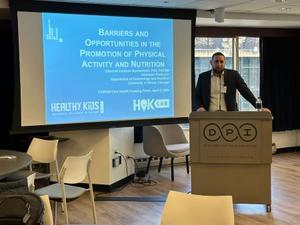image:
University of Illinois professor Eduardo Esteban Bustamante speaking at FAPESP Week Illinois
view more
Credit: Elton Alisson/Agência FAPESP
The concept of “One Health”, which emphasizes the relationship between human, animal, plant, and environmental health, has been gaining ground in scientific debate in recent years. Researchers from Brazil and North America using this approach presented their research on Tuesday (April 9) in Chicago, USA. FAPESP Week Illinois.
One of the panelists was Eduardo Esteban Bustamante, a professor at the University of Illinois at Chicago. He spoke about behavioral interventions that have been tested to promote physical activity and healthy eating. Researchers say that despite the obvious benefits, Americans still do not adhere to this practice.
“The percentage of Americans meeting nutrition and physical activity recommendations remains very low. Among children ages 6 to 11, the percentage is 49% for boys and 35% for girls. As we grow older, these rates worsen, dropping to 7% and 4%, respectively, in the 16-19 age group, and plateauing at 3% and 2% after age 60, Bustamante said. When it comes to diet, the reality is not so good. “Just over 10% of American adults over the age of 18 regularly eat fruits and vegetables,” the researchers said.
In an attempt to change this reality, behavioral health intervention programs have been developed and tested across the country. In the past few years alone, he has produced more than 3,000 evidence-based physical activity and nutrition interventions in the United States. According to a study conducted by researchers, about 200 of them are publicly available in public repositories.
“These practices are published on public websites, so people can access them and follow the instructions correctly to, for example, become more active and eat more fruits and vegetables. We can,” Bustamante said.
The problem, however, is that 90% of scientifically tested physical activity intervention programs in the United States face dissemination and implementation barriers that limit their potential impact on public health. One factor is a misalignment between people's expectations and where they should be implemented, the researchers said.
“I've worked on a number of intervention programs and one of the problems I identified was that we didn't think about our target audience before we started, and I found that people weren't engaging. We need to think about how to engage our target audience so that the intervention fits and aligns with their goals from the beginning,” he said.
“We also need to stop thinking of nutrition and physical activity as just medicines that benefit our health. can use them to achieve their desired goals,” Esteban said.
Based on this finding, the researcher and his collaborators began developing and testing a new physical activity intervention program in schools and communities.
For example, a project conducted in collaboration with the University of California, Irvine uses physical activity as a way to learn mathematics in schools. To this end, the educational institution's basketball court was redesigned to teach children about fractions and decimals.
“As a result, children were able to learn mathematics in a more engaging way, in addition to all the health benefits of physical activity,” he said.
Another project conducted in the Chicago Park District, one of the largest and oldest park districts in the United States, uses sports and recreation to develop communication, emotional, and conflict resolution skills in at-risk youth. doing.
“This program is aimed at high school students. We try to provide them with jobs during the summer so they can stay in the park and work, and we help them develop behavioral skills through physical activity. We encourage people to wear them,” Bustamante explained.
Multifactorial causes
Mark Rosenblatt, dean of the University of Illinois College of Medicine, said new approaches to behavioral health interventions are also essential to addressing the diabetes epidemic in the United States.
“One in 10 people in the United States has diabetes. The causes of this disease are multifactorial. Not only do people not take their insulin or high blood sugar medications, but they also eat poorly and don't exercise. “It's also because we haven't done it,” he said.
“Tackling this problem will require a multifaceted approach, including interventions in schools. We are working with local organizations to improve diet quality and encourage physical activity, while at the same time We're trying to study the molecular basis of itself,” Rosenblatt said.
Social determinants of health are an issue that Chicago health care providers and health systems have worked hard to understand and intervene in, researchers say.
“It’s humbling to realize that only about 15% to 20% of a person’s health is related to the solutions we develop in hospitals and clinics. , and postcodes are correlated with many other factors, such as socio-economic level, social and community context,” he said.
Emphasizes that environmental risks play a fundamental role in the development of degenerative diseases and cancer Leandro ColliProfessor of Medical School Ribeirão Preto, University of São Paulo (FMRP-USP), Supported by FAPESP.
“We know that genetics are not the only cause of cancer. There are also very strong environmental factors. We can intervene with genetic risk factors, but we also need to look at the environment.” he emphasized.
The researchers are working with collaborators on a project aimed at identifying signature mutations in cancer patients. This is a recently emerged concept in which it is possible to observe mutations in cells and try to reconstruct their origin and the factors that caused them.
“We are starting a project to follow a series of patients to better understand the risk factors for cancer-causing mutations, including exposure to tobacco, solar radiation, and sugar cane burning in Ribeirão Preto. It's the region,” Colli said.
For more information about FAPESP Week Illinois, please see below. fapesp.br/week/2024/Illinois.


